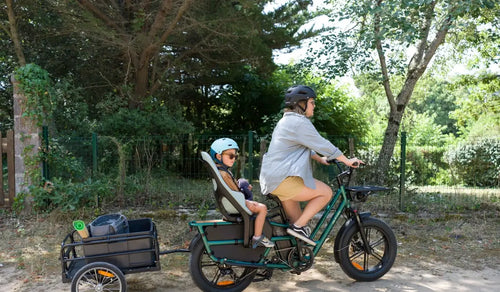Which E-Bike Motor Completely Decouples?
Electric bikes have been around since the 1980s. The demand for e-bikes has been increasing year after year. Due to the mobility transition and changing everyday conditions, more and more people are choosing to purchase an electric bicycle. One contributing factor is decoupling technology. In this article, we will explain which e-bike motors completely decouple.

What Is Behind the Decoupling Technology?
E-bikes offer a wide range of advantages. They are not only sporty but also come with pedal assistance, which is especially helpful on uphill routes. For this reason, people of all ages enjoy using e-bikes.
Some e-bikes feature motor decoupling. If the motor exceeds the speed limit of 25 km/h, it disengages and switches to freewheel mode. This also happens when the battery is empty, serving as a safety mechanism. The e-bike can still be ridden without motor assistance, though more physical effort is required.
How E-Bike Motors Work
The motor is a central component of an e-bike and ensures proper operation. There are different types of motors, but the most common are hub motors and mid-drive (bottom bracket) motors.
-
Front Hub Motor:
Mounted on the front wheel, this is the most cost-effective option. It doesn’t interfere with pedals or the chain. A sensor analyzes the rider’s pedaling speed to determine how much power the motor should deliver. However, on slippery or sandy terrain, stability can be compromised. -
Rear Hub Motor:
Integrated into the drivetrain, it provides efficient power transfer. However, under heavy load (like steep inclines), poor leverage ratios may cause the motor to overheat. -
Mid-Drive Motor:
Located near the crankset, also called the bottom bracket motor. This type is widely used in various e-bike models, including city bikes and e-MTBs.
Decoupling Function Explained
Once the e-bike motor reaches 25 km/h, the gear system decouples and switches to freewheel mode. The bike can continue moving without noticeable resistance from the motor.
Advantages of Fully Decoupled Motors
In addition to the safety mechanism, decoupled motors provide several benefits:
-
Reduced Rolling Resistance:
The motor disengages, reducing resistance while riding, even without assistance. -
Improved Energy Efficiency:
Energy losses are minimized, which boosts overall efficiency.
Comparing decoupled and non-decoupled motors reveals performance differences. Non-decoupled motors experience more wear on gears and chains and tend to be noisier. Decoupled motors may have shifting limitations and reduced climbing ability.
Decoupled Motor Technology in Electric Bicycles on the Market
There are now various decoupled motor technologies available. We’ve summarized and explained the three most well-known for you:
-
Bosch E-Bike Motors
Some Bosch e-bike models are equipped with decoupling technology. For example, the motor gear unit of the CX model can be completely decoupled. This means there is virtually no pedaling resistance above the 25 km/h limit. This also applies in Off mode. -
Shimano
The Shimano motor guarantees a comprehensive riding experience. The drivetrain adapts individually to the terrain. When the e-bike reaches the maximum speed of 25 km/h, the motor fully decouples. This has a positive effect on energy efficiency. -
Brose E-Bike Motors
The unique feature of Brose motors is their extensive decoupling technology. The e-bike can be ridden without motor assistance—completely without resistance.
 About Fiido Electric Bikes
About Fiido Electric Bikes
Fiido e-bikes offer numerous advanced technologies. However, it's important to note that currently, no specific decoupling technology is integrated into Fiido models. These e-bikes are known for their high performance and efficiency, especially in urban environments and on rough terrain. Even without decoupling, Fiido guarantees safety and improved energy efficiency through advanced motor and battery technology. Each Fiido e-bike is designed to meet individual riding needs and deliver an optimal experience.
Conclusion
In conclusion, although Fiido electric bicycles do not offer specific motor decoupling technology, they are still known for their high quality and advanced technology. If you're looking for one of the best e-bikes that is both reliable and comfortably foldable, Fiido models are definitely worth considering. These e-bikes provide an excellent riding experience and meet various needs for both urban and off-road rides.
This is directly reflected in the riding experience.
Do you also want to enjoy a free and comfortable riding experience? Then give a Fiido e-bike a try.
An electric mountain bike is very popular among many passionate e-bike fans. On the Fiido website, you'll find many great models that meet a wide variety of needs. Take a look at the Fiido collection and choose the right model for you. If you're unsure, it's a good idea to consult a sales representative beforehand.
E-Bike Motor Decoupling Technology
1. What does it mean when an e-bike motor is “decoupled”?
A decoupled motor means that once the motor reaches its speed limit (usually 25 km/h), it disengages, allowing the bike to continue without motor resistance. This improves the ride feel and energy efficiency.
2. Do all e-bikes have a decoupling function?
No, not all e-bikes feature motor decoupling. This function is typically found in higher-end models from brands like Bosch, Shimano, and Brose.
3. Which e-bike motors are known for fully decoupling?
Bosch, Shimano, and Brose are some of the most popular brands that offer fully decoupled e-bike motors, ensuring minimal resistance once the speed limit is exceeded.
4. What are the benefits of a fully decoupled motor?
The main benefits include reduced rolling resistance, improved energy efficiency, and a smoother overall ride, especially when the motor is not in use.
5. Can I still ride an e-bike without decoupling technology comfortably?
Yes, many e-bikes, such as those from Fiido, are designed to offer smooth pedaling even without decoupling, making them comfortable to ride in both assisted and non-assisted modes.
















